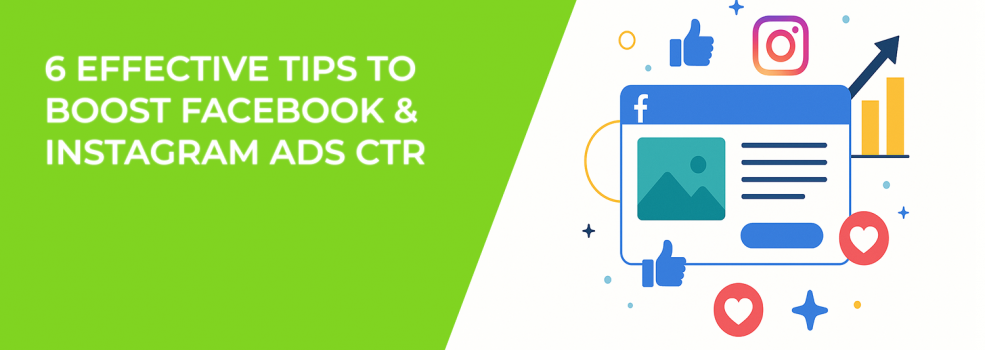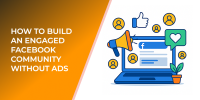Click-through rate (CTR) is more than a metric — it's a clear signal of ad relevance and user intent. A high CTR doesn’t just drive more traffic. It improves your Quality Ranking, lowers CPC, and trains Meta’s algorithm to find more valuable users. But here's the catch: most brands are still relying on basic tips like “use a good image” or “write compelling copy.”
You need more than that. Let’s break down six advanced strategies that go beyond the usual advice — built to actually move the needle on your CTR.
1. Create Pattern Interrupts With Unexpected Visuals
Yes, visuals matter. But not just “bright” or “high-res” ones. The goal is to break visual monotony and disrupt the scroll in a way that makes the brain pause — even for half a second.
Instead of standard product shots or lifestyle images, try these:
-
Deliberate visual tension: juxtapose unusual elements (e.g. placing your product in a strange setting, like a vacuum in a forest).
-
Uncommon color palettes: most brands overuse blue or red. Use softer pastels or neon gradients to stand out.
-
Creative use of whitespace: minimalist designs actually pop in busy feeds.
-
Memetic visuals: subtle meme-style formats (without full-on jokes) that blend into native feed content often outperform “professional” creatives.
Also, test lo-fi content. Authenticity often outperforms polish. A “phone-recorded” demo or unfiltered testimonial can spike CTR by feeling native — especially on Instagram Stories or Reels.
Pro tip: Use dynamic video overlays to highlight your CTA, offer, or objection-handling messages within the video. For example, overlay "Only 3 Left – 60% Off Ends Today" in a Story frame. You’ll often get higher engagement without changing the asset itself.
Need deeper tactics? Here’s how to solve low click-through rates on Facebook ads.
2. Leverage Emotional Trigger-Based Copywriting
Forget generic hooks. If your copy doesn’t emotionally nudge the reader, it won’t convert the impression into a click. To do this well, you need to understand the real reason your audience might care.
Try copy formulas that tap into:
-
Loss aversion: “Still boosting posts and hoping for results? You could be losing 40% of your ad budget every month.”
-
Status & identity: “Most marketers test creatives — top-performing ones test psychology.”
-
Relatability: “You launched the ad, waited 3 days... and nothing happened. We’ve been there.”
Also, map your copy structure to a real funnel stage. A user in the awareness stage might respond better to curiosity and agitation. A warm audience may need urgency or proof. Avoid writing a one-size-fits-all ad.
Pro tip: Use “nested hooks” — write your first line to get the reader to read the second. Then make the second so tight they want to read the CTA. It’s a chain reaction. One broken link, and the CTR collapses.
Writing for attention requires structure. See how to craft compelling Facebook ads copy that converts.
3. Hyper-Segment Custom Audiences With Behavioral Filters
Advanced advertisers don’t just target interests or lookalikes. They create micro-segments based on real behavior — then tailor creatives and offers to each.
Here are some segmentation hacks that consistently yield higher CTR:
-
Retarget video viewers based on watch time, not just views. Users who watched 75%+ of your explainer video? Give them a CTA to book a call. 10-second viewers? Offer a quiz or lead magnet first.
-
Build lookalikes off micro-conversions, not just purchases. Try initiating checkout, “add to cart,” or even high scroll depth on a landing page.
-
Exclude site visitors who bounced in under 5 seconds — they’re likely not qualified. You’ll improve CTR and ROAS by cutting noise.
Go deeper with event-based retargeting. If someone engaged with your Instagram profile in the past 14 days but didn’t click any Story links? Serve them a native-style Story ad with one clear CTA. Meet them where they left off.
Pro tip: Use custom metrics to build audiences. Facebook lets you create audiences from aggregated events — like “people who clicked on two ads in the last 30 days.” These are your highest-intent users. Speak to them directly.
Also explore why your Facebook ads CTR dropped and how to fix it for more audience-specific solutions.
4. Use Objective + Optimization + CTA Triangulation
CTR doesn’t live in a vacuum. You can run the same creative with two different campaign objectives and get wildly different results. Most advertisers overlook how much CTR is influenced by the backend setup.
Here’s what to align:
-
Objective: If you're optimizing for Conversions, Facebook may show the ad to fewer people but with better intent. For CTR testing, use the “Link Click” or “Landing Page View” objective first.
-
Optimization event: For top-funnel ads, optimize for View Content or Time on Page. This widens reach and lets you identify high-CTR creatives early.
-
CTA button: “Learn More” typically outperforms “Shop Now” unless your audience is ready to buy. For lead gen, test “Get Offer,” “Subscribe,” or “Send Message” — Messenger ads in particular tend to spike CTRs.
Most marketers stick with the default settings, but triangulating these three layers can give you a CTR edge that’s invisible in the creative itself.
Pro tip: Test a campaign with identical creatives but different optimization events and CTAs. You’ll often find CTR gains of 20–40% just by adjusting backend settings — not the ad itself.
To understand why structure matters so much, read The Ultimate Guide to Facebook Ad Formats.
5. Preload Users With Warm-Up Content (Even in Cold Campaigns)
The best way to boost CTR is to make your ad feel familiar — even when users haven’t seen your brand before.
Here’s how:
-
Use engagement campaigns as warm-up ads. Show value-first content (e.g. tutorials, opinion pieces, short reels) for $1–$2/day. Then launch conversion ads to that engagement audience. CTR will usually double or triple.
-
Use carousel ads to build progressive context. Start with pain point → benefit → solution → testimonial → CTA. Each card “preps” the user for the next click.
-
In cold campaigns, test sequential ads — ad 1 introduces the problem, ad 2 (shown 2–3 days later) pitches the solution. Meta supports this setup with built-in sequencing.
This strategy isn’t just about CTR. It’s about priming your audience. People don’t click because you told them to — they click because they feel like they should already know you.
Pro tip: Use Instant Experiences to embed mini-funnels inside the ad unit. CTR to the first layer counts — and if they engage with it, retargeting becomes much more precise.
To avoid early drop-offs, also learn how to spot underperforming Facebook ads before they tank your campaign.
6. Analyze Click Depth, Not Just CTR
Here’s something advanced advertisers know: not all clicks are created equal.
A 4% CTR sounds great — until you realize most users bounced after two seconds. Instead of chasing surface-level CTR, dig deeper into click quality.
What to check:
-
Time on site;
-
Scroll depth or video play %;
-
Page engagement vs. link clicks;
-
CTR by placement (Stories vs. Feed vs. Reels);
-
Bounce rate by campaign.
Then, optimize creatives based on click depth. If your Stories have high CTR but no conversions — maybe the CTA is unclear. If Reels drive long page sessions — double down with a lookalike audience.
Use UTM parameters to tie creative variations to click behavior in GA4 or other analytics platforms. That’s where the gold is.
Pro tip: Set up custom event tracking on your site that fires after 8–10 seconds. Then, build retargeting audiences based on this “click depth.” You’ll be filtering for actual attention — and your next ad will feel hyper-relevant.
To go beyond basic performance metrics, read How to Analyze Facebook Ad Performance Beyond CTR and CPC.
Wrapping It Up
Improving your Facebook and Instagram ads’ CTR isn’t just about slapping on a better headline or switching to a brighter image. It’s a strategy — one that combines smart targeting, emotional hooks, psychological nuance, and deep backend testing.
If you’re still using the same creative for cold and warm audiences, optimizing for conversions without enough data, or writing copy that reads like a sales script, you’re leaving clicks (and revenue) on the table.

